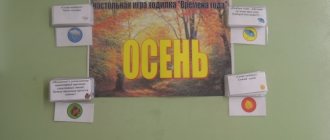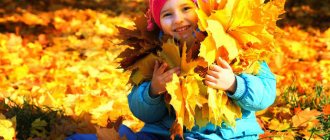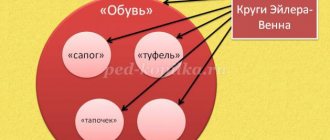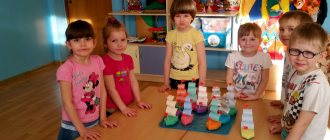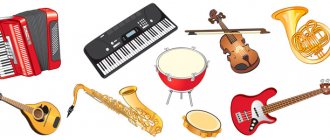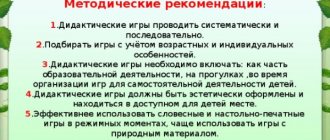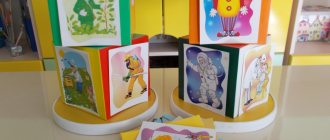Consultation “Didactic materials in the work of a preschool teacher”
Galia
Consultation “Didactic materials in the work of a preschool teacher”
Didactic materials in the work of a preschool teacher
“Leading activity is activity, the implementation of which determines the emergence and formation of the basic mental new formations of a person at a given stage of development of his personality.” [3]
L. S. Vygotsky laid the foundations for ideas about leading activity.
Further, the hypothesis about the leading type of activity was expressed in 1944-45. A. N. Leontiev and was developed in of D. B. Elkonina, V.V. Davydova and others, according to this hypothesis, leading activity is a criterion for the periodization of mental development, an indicator of the child’s psychological age. According to this periodization, the leading activity of preschool children is play.
“Game is the leading type of activity for a preschool child”
.
“Play is an activity in which a child first emotionally and then intellectually masters the entire system of human relationships. A game is a special form of mastering reality by reproducing and modeling it.” In order for the game to educate the child and bring positive emotions during the game, educators select and create special teaching aids . With the help of didactic games, children develop, educate and learn during their natural activities. [4]
To create such a game, didactic materials .
What is the importance of didactic material in kindergarten ?
According to the Federal State Educational Standard for Preschool Education, the developing subject-spatial environment in which children find themselves must, first of all, be content-rich. That is, the educational space must be equipped with means of training and education , appropriate materials ( didactic , including consumable gaming, sports, recreational equipment and inventory. In this context, properly selected didactic materials . They are the teacher’s assistants for the development of the child’s abilities and learning something new.Such materials should be aesthetically attractive, pleasant to the touch, colorful, bright to stimulate interest and attract the child’s attention.
What is didactic material ?
“ Didactic material is a special type of teaching aids, the use of which helps to enhance the cognitive activity of students and save learning time.” [2]
Didactic material , educational material - a type of visual teaching aids (maps, tables, reagents, plants, etc., distributed to students for independent work in class or at home or demonstrated by a teacher; didactic material is also called collections of tasks and exercises.
Didactic materials in preschool institutions are materials that are simple in content and aimed at learning through play, complement it and are used in the process of its implementation (educational games, various cards, drawings, diagrams, presentations)
.
What are didactic materials in the form of a game ? During the game, the child receives a variety of information and learns new skills and knowledge. Play is a part of a child’s life, but through the process of properly selected entertainment, the young explorer will learn. The game brings the child pleasure from the process itself; the result is not important for him. Every game has rules, and the child learns them, remembers them, and thereby learns.
During the game, the child acquires new knowledge and skills.
didactic materials should have : variability of forms and methods of presenting material ; focus on proactive learning; engaging content; focus on developing thinking abilities.
Purposes of using didactic materials :
development of fine motor skills and tactile sensitivity;
formation of ideas about the external properties of objects (shape, color, size, position in space)
;
creating a positive emotional mood;
development of cognitive processes (memory, attention, thinking)
;
development of speech skills;
teaching numeracy and literacy.
All didactic materials are divided into several types:
Subject-shaped manuals reveal the most general, essential characteristics of the objects being studied. Natural (made from natural materials )
and three-dimensional
didactic materials :
Natural visual aids are aids created from natural materials .
Three-dimensional didactic materials are manuals that clearly demonstrate the process or structure of the subject under discussion (models, layouts, dummies, etc.)
.
Iconic didactic materials - designed as material in pictures , handouts , demonstration material (stands, posters, multimedia presentations, etc.)
Figurative-symbolic visual aids are materials that allow children to remember the image of the object being studied as a whole and abstract from particulars (subject and subject pictures, various cards, portraits, applications, photos, films, etc.).
Conventionally symbolic didactic material is material that reveals or examines particulars or details according to one or more active characteristics.
didactic materials for kindergarten yourself. The process of creating manuals includes a number of stages:
Statement of the goal - what exactly the developed didactic material . The benefit must be age-appropriate , understandable and accessible.
Selecting a topic within which teaching material (for example, “Primary colors”
).
Think over the concept of the aid - what type of visual aid is being created: cards, a stand, a poster or an entire game.
Select suitable materials to create a visual aid - the material should be bright so that the child can easily remember what was depicted. The material should not be brittle or easily breakable. The material should be as safe as possible for preschoolers. The materials used must be hypoallergenic. The material must withstand sanitary treatment .
Assembling the material - the information depicted or presented must characterize the world around us and correspond to reality; the didactic material was beautifully and neatly designed.
Timely planning of the use of created didactic material .
The selection of didactic materials depends not only on the material equipment of the preschool educational institution , but also on the set goals of educational work , methods, age of the children, as well as on the characteristic features of individual educational educational institutions.
The use of didactic materials in kindergarten helps to develop the cognitive, communicative and creative abilities of preschoolers of all age groups. When applying benefits, the teacher should remember the wide range of choices for their presentation. Making didactic materials with your own hands allows you to implement various pedagogical ideas in the educational process of a preschool educational institution. The main thing is to correctly develop the manuals , think them through and arrange them. A variety of methodological recommendations and the author’s own imagination will help with this. [9]
Bibliography:
1. Kulikovskaya T. “ Didactic material “The World Around Us”, “Animals of the Arctic and Antarctic”
2. Moiseev V. B. Information technologies in the higher education system. - Penza, 2002. p. 94)
3. Popular psychological encyclopedia. — M.: Eksmo. S. S. Stepanov. 2005. (p. 102)
4. Professional education. Dictionary. Key concepts, term, current vocabulary. - M.: NMC SPO. S. M. Vishnyakova. 1999.
5. Psychological and pedagogical dictionary. / Comp. Rapatsevich E. S. – Minsk, 2006, p. 184-185.
6. The role of didactic materials in the learning process [access mode: https://letopisi.ru/index.php]
7. https://www.montessori-center.ru/kursy-i-seminary_744/didakticheskij-material/
8. https://info-4all.ru/obrazovanie/chto-takoe-didakticheskie-materiali/
9. https://melkie.net/metodicheskie-razrabotki/didakticheskiy-material-dlya-detskogo-sada-svoimi-rukami.html
10. https://psychlib.ru/mgppu/ode/ode-001.htm#$p193
DIY didactic games for speech development for children 4-7 years old
DIY didactic games
on speech development for children 4-7 years old
Didactic game "Seasons"
This game is intended for use with children aged 3 to 7 years.
Purpose of the game:
to help clarify and expand preschoolers’ ideas about the seasons, seasonal changes occurring in living and inanimate nature, the development of connected speech, and cultivate interest in cognitive and play activities. Each age group has its own version of the game.
Didactic game «
Seasons
"
has a developing, educational and educational meaning. It can be used in almost any type of children's activity. This game is perfect for individual, subgroup and frontal work with preschoolers.
Material:
4 pictures depicting the seasons, and cut cards with signs of the seasons.
The game must be preceded by a conversation.
For example:
In winter the days are short. The sun is low and warms weakly. Snow falls. Cold. People wear winter clothes. In winter we celebrate everyone's favorite holiday - New Year.
In spring, the days become longer. The sun is warming better. It is getting warmer. Snow is melting. Streams are flowing. Leaves appear on the trees. Grass begins to grow. Flowers are blooming. Migratory birds arrive. People wear demi-season clothes. In the spring we celebrate everyone’s favorite holiday - March 8th
In summer the sun is high, shines brightly, and warms well. The weather is hot. Flowers bloom and berries appear. People wear summer clothes. You can swim in natural reservoirs and sunbathe.
In autumn, the days become shorter and shorter. The sun is lower. It's getting cooler. The vegetable harvest is ripe. Leaves are falling from the trees. Migratory birds fly south. It rains often. People wear warm clothes. The most famous autumn holiday is the Day of Knowledge.
Game task
is to put cards with signs of the season in the windows of the corresponding card and explain your choice.
Rules of the game:
Large cards are given to the participants of the game. Small cards are laid out on the table. Children take turns taking one card at a time and see if this card is suitable for a large card, if there is such a sign for this time of year. If not, the small card must be placed back on the table. The first one to close all the windows wins. The game can be used both in classes and in children’s free independent activities.
Each age group has its own version of the game.
Didactic game
“Cleaning the room: put it on the shelves”
Purpose of the game:
promote the development of logical thinking, memory, speech, the ability to generalize and justify.
Didactic task:
Exercise children in classifying objects. The child is required to find a group of similar objects, primarily by purpose, and arrange them on the right shelves.
Materials:
a box in the shape of a cabinet with shelves and cut cards with objects.
Progress of the game:
We lay out cards with drawn objects in disarray on the table. We invite the child to do the cleaning. You need to arrange items on shelves according to their purpose and name the group (clothing, dishes, toys, shoes, household chemicals, medical supplies).
Didactic
game
“Carlson Away”
The goal of the game:
consolidating the use of relative adjectives and the method of their formation in children’s speech, activating the vocabulary of adjectives.
Materials:
A large card with Carlson and the Kid and small cards with images of treats (jam, sweets, juice).
Progress of the game:
Children take turns taking small cards and calling out the treats.
For example:
Imagine that Carlson came to visit us. He has a great sweet tooth, and we need to treat him with something tasty.
What can we treat Carlson to? Jam! What kind of jam? Banana (orange, strawberry, etc. - put the desired card). What else can we treat Carlson to? Sweetie! What kind of candy? Banana (orange, strawberry, etc.). ... Juice. Banana, orange, strawberry juice.
Didactic
game
“My, my, mine, mine”
Target:
exercise children in classification, correlating nouns of masculine, feminine, neuter gender; enriching the vocabulary by selecting words; teaching children to agree nouns with possessive pronouns my, mine, mine, mine.
Rules of the game
consist in the correct selection by participants of cards with images of characters and objects, the name and names of which must be ordered in accordance with masculine, feminine, neuter genders.
Materials:
Large cards of four and small cards with objects
The cards depict a Hedgehog with an apple and small cards depicting objects
Progress of the game:
Cards are placed on a special field, separate for each type. After finishing sorting the cards by gender, the children must explain their choice. Children are invited to put pictures on the apple windows called “Mine, mine, mine, mine.”
Be sure to say at the same time, for example: “my fish.”
Didactic
game
“He, she, they, it”
Target:
exercise children in classification, correlating nouns of masculine, feminine, neuter gender; enriching the vocabulary by selecting words; teaching children to agree nouns with pronouns he, she, they; and also to develop in children the ability to distinguish the gender of possessive pronouns mine, mine, mine.
Rules of the game
consist in the correct selection by participants of cards with images of characters and objects, the name and names of which must be ordered in accordance with masculine, feminine, neuter genders
Children are invited to arrange the pictures into houses called “He”, “She”, “They”. The child puts pictures about which one can say “my” in the house called “He”, pictures about which one can say “mine” - in the house “She”, “mine” - “It”.
Didactic game
"Sound Clock"
(how the words differ).
This didactic game will help you figure it out and understand that one single letter can change the meaning of an entire word.
This game is perfect for individual, subgroup and frontal work with preschoolers
Each age group has its own version of the game.
Target:
consolidate, clarify and activate children’s knowledge about the spoken word
And thunderous material:
large size “Sound Clock” manual and cards with objects.
Option 1. (for children 4-5 years old)
Rules of the game:
1.Say the names of the objects depicted.
2. Find two word names that sound similar and point to them with the hands of a clock.
3. Find two words - names that are not similar in sound and point to them with the hands of a clock.
4. Find two short words, indicate with arrows, and vice versa - two long words.
5. Find two word names that begin with the same sound.
Option 2. (for children 4-7 years old)
Rules of the game:
1. Select and name the first and last sound in the names of the pictures.
2.Name first those pictures that begin with voiced consonants, then with voiceless ones.
3. Determine what is the first and last sound in the name of the picture: hard or soft consonant, vowel.
4.Choose words that begin with the same sound as the name of the picture pointed to by the small arrow.
5. Find words ending with the same sounds as the name of the picture, which is pointed to by the small hand of the clock.
6. Come up with phrases consisting of two, three and four words, be sure to include the names of those pictures that the small hand of the clock points to.
Didactic game
“Guess the word”
(puzzles for preschoolers)
Read by first letters is a very fun and entertaining game for children aged 5-6 years, which also develops reading skills. These are the simplest puzzles. The game develops memory, attention, logical thinking, phonemic hearing. The game reinforces the ability to identify the first sound in a word and write it using a letter, reading skills, and sound-letter analysis. Target:
to train children in identifying the first sound in words and composing words, to promote the development of phonemic hearing.
Game material:
cards with pictures, a set of letters and symbols (blue, green and red squares)
Didactic task:
Having identified the first sound in the name of each picture, guess the word and read it (lay out the word with symbols and letters)
Progress of the game:
Children solve the word by identifying the first sound and lay out the word using symbols and letters.
Didactic game
"Treat the animals"
Target
:
practice dividing words into syllables, finding long and short words (forming an idea of the syllabic composition of a word).
And thunderous material:
Three large cards depicting a spruce, a birch and a bush, cards with pictures
.
Progress of the game:
The teacher suggests:
1. put words-delicacies for forest dwellers under a bush, fir tree and birch. Under the bush you need to put words consisting of one syllable, under the Christmas tree words consisting of two syllables, but under the birch tree words - of three syllables.
To do this, you need to determine the number of syllables (parts) in a word.
Children:
Apple. The word apple has three syllables. The first syllable is YAB. I will put it under a birch tree (you can clap the word).
2.Name the shortest word. Find the longest word
Didactic game
"Syllable watch"
This is an interesting, entertaining game for children 5-7 years old that develops reading skills. The game develops memory, attention, logical thinking, phonemic hearing. The game reinforces the ability to identify syllables in a word and contributes to the development of sound-letter analysis of the word.
Target:
practice composing words from syllables;
Game material:
manual "Syllabic clock"
Rules of the game:
Using syllables, game participants form words that are encrypted in the manual and place arrows on them (you need to add another syllable to one syllable, so we get a word).
Syllables: KO-PA - RA -SA -TY - LA - FOR - LI
As a result, we get the words :
fox, Lisa, linden, goat, bark, braid, cats, couple, Lara
Didactic game
"Magic Circle"
Target:
exercise in identifying the first sound in a word, promote the development of phonemic awareness. Continue to expand children's vocabulary through the use of qualitative, possessive and complex adjectives. Continue to practice the formation of different degrees of comparison of adjectives, adverbs and the use of nouns in the instrumental case.
Game material:
manual "Magic Circle"
Rules of the game:
The tool consists of four rotating wheels. On the first circle there are cubs. on the second - the mothers of the cubs, on the third - the house (dwellings), - on the fourth - parts of the animal’s body: tails, paws, fur.
Children spin the wheel and find the mothers their cubs, a home, identify parts of the animal’s body, and thus answer questions :
Who with whom? Where live? Whose House? What part of the body is this? Whose tail? Whose paws?
Children's answers:
A little fox and a fox live in a hole. Fox hole, fox tail
IN:-
And if a fox has a long tail, does that mean what kind of fox is it? - long-tailed
IN:-
And if a hare has a short tail, what kind of hare does it mean? - short-tailed
IN:-
The wolf's tail is long, and the fox's tail is even……longer, more…. long
IN:-
The bear has a tail…..small, and the bunny has an even….smaller tail.
